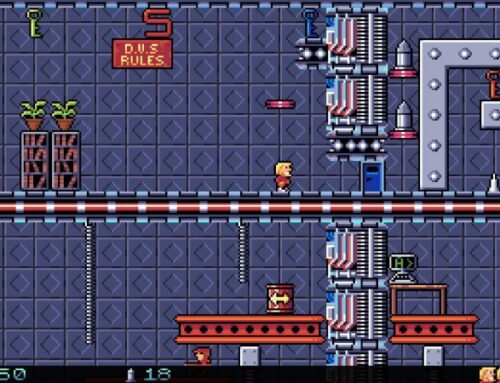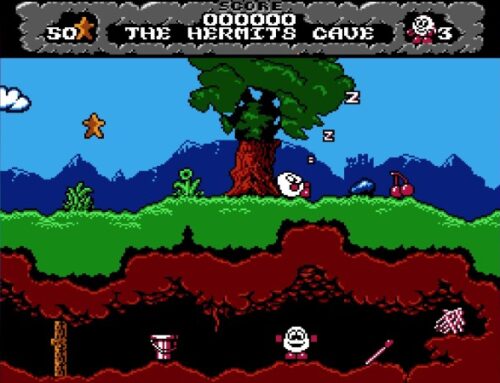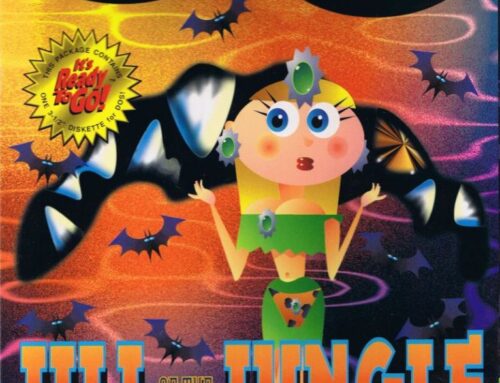When it comes to retro gaming, everyone seems to have a slightly different “cutoff point” with regard to how far back into gaming history they’re willing to explore before the games become too old and clunky to bother with. If you want to truly put this to the test for yourself, the Atari Arcade 1 cartridge for Evercade offers some of the oldest video games in existence — games that are worthy of your respect. But are they still enjoyable?
Only one way to find out! Let’s take a look at what’s on offer.
Asteroids

While the Atari Arcade 1 cartridge says it features Asteroids Deluxe, what we actually have is the original arcade version of Asteroids atop the distinctive background of Asteroids Deluxe. The Evercade team is aware of this, so it’s possible this will be fixed with a subsequent firmware update — remember, Evercade firmware updates are capable of directly patching cartridges — but at the time of writing, this is what you’ve got.
That’s no bad thing, though, because Asteroids is a timeless classic that, although challenging to get to grips with — particularly if you’re not accustomed to the “turn and thrust” control scheme — presents a compelling and satisfying challenge that escalates at a good pace.
As a game that was originally presented on a high-resolution vector monitor, any home port of Asteroids suffers a little from a visual perspective by virtue of the fact that conventional raster-based displays work completely differently — and the Evercade version is no exception. The game plays smoothly and responsively, though, and even if the visuals aren’t quite as sharp as they would have been on the original arcade machine, everything is still nice and clear.
There are now three different versions of Asteroids available on Evercade: the Atari 2600 version, the Atari 7800 version and this arcade version. For my money, the Atari 7800 version is still the best, but this one comes a close second. Despite its myriad game variations, the 2600 version of Asteroids is just too predictable in comparison to the other versions to be truly satisfying.
Canyon Bomber

Canyon Bomber is one of Atari’s simplest games, but that’s also one of its biggest strengths. Its single-button control scheme means that it’s a game pretty much anyone can understand; simply hand them a controller and tell them the right button to press, and you’ll be having two-player fun before you know it.
In single player, Canyon Bomber is still surprisingly compelling. While it’s not difficult to beat the computer player’s score — they tend to get themselves “out” well before you will — the real challenge comes in trying to see if you can accurately clear an entire canyon before losing all of your misses. It’s not easy!
The Atari 2600 version of Canyon Bomber is available on one of the previous Atari Collection cartridges for Evercade. While that version offers more varied ways to play, the better visuals and more satisfying sound effects of this version make it the more fun version in my book.
Centipede

Dona Bailey and Ed Logg’s classic went down in history for being one of the first times a video game had significantly appealed to a female audience as well as men, but it’s also legendary as being a highly entertaining shoot ’em up with distinctive mechanics that still hold up very well today.
Centipede is about accuracy, quick reactions and responding to unexpected threats, and the arcade version sees all of these elements dialled up to the max. While the Evercade version lacks the speedy responsiveness of the arcade original’s trackball controls, the console’s excellent directional pad is a more than adequate substitute.
Plus with the Evercade’s save state feature — particularly the excellent Quick Save option introduced in the Evercade VS and the 2.0 Evercade handheld firmware — you can keep your high scores rather than having to fill up the high score table again every time you start the game.
Centipede is one of the best games on the cartridge — and even those who are most resistant to really old games will more than likely find something to enjoy here.
Crystal Castles

This quasi-3D take on the Pac-Man formula is a challenging game to get started with thanks to the highly sensitive controls on its protagonist Bentley Bear, but once you get a good feel for how he moves, you’ll be zipping around the levels and nimbly avoiding enemies before you know it.
While obviously inspired by Pac-Man, Crystal Castles brings enough unique mechanics to the table to make it more than just a simple clone from a new perspective. In particular, the varied and interesting ways in which you can stun or defeat enemies gives a certain element of strategy to each level — and even the game’s most feared foe, a swarm of bees, can be dealt with through proper planning and preparation.
Crystal Castles is a difficult game that some might find themselves bouncing off due to how unforgiving it can be at times — but persist and practice and you’ll find an enjoyable maze action game that plays excellently on Evercade.
Liberator

This somewhat lesser-known spiritual successor to Missile Command is an absolutely excellent game, challenging you to blast missile bases on spinning planets — a seriously impressive graphical effect back in the day. Like Missile Command, success in Liberator is all about “leading” your shots and catching enemies in explosions rather than aiming directly at them — and things can get very hectic very quickly.
As with many of Atari’s early arcade games, the difficulty level arguably ramps up just a little too quickly to be comfortable for beginners, but put in a bit of practice and you’ll be recording impressive high scores before you know it — particularly as the score multiplier escalates rapidly as you progress through the levels.
Once again, the game doesn’t quite have the responsiveness of the original arcade cabinet’s trackball controller on Evercade, but the D-pad does a great job in allowing you to feel fully in control of what’s going on. As with some of Atari’s other early arcade games, some may find themselves bouncing off this one due to the initial difficulty factor — but as always, you’ll be surprised at how much further you can progress with just a little practice and getting to know the game’s mechanics.
Lunar Lander

Another game originally presented on a vector display, Lunar Lander also suffers a little in the visual department in the conversion to Evercade, but not so much that you can’t see what’s going on. Your challenge here is to safely land a lunar module on a craggy moon surface — you’ll need to rotate and apply thrust in order to control both your horizontal and vertical velocity in order to succeed.
The original arcade machine allowed you to select the difficulty mode by pressing a button, which would highlight a panel on the cabinet itself to indicate what level you were playing on. In the Evercade version, the button to select difficulty is implemented, but there’s no on-screen indicator so you’ll just need to know that there are four different levels to play at. Anything beyond the basic beginner level is near-impossible, though — particularly on a single “coin’s” worth of fuel — so you may just want to stick with the default mode anyway!
As a very old game, Lunar Lander might be a bit of a hard sell for more “modern” retro gamers, but it’s worth a go or two just to see a bold experiment in centring an arcade game around distinctly simulation-style mechanics.
Millipede

It’s Centipede, but faster, smoother and much more frantic. While it might initially appear very similar to its illustrious predecessor, the vastly increased number of things that you’ll find happening at any given time during a Millipede session will make it clear that this is a distinct experience. And on Evercade, it runs as smooth as butter, with responsive controls and enjoyable gameplay.
It’s perhaps best to familiarise yourself a bit with Centipede before moving on to Millipede, since the latter definitely builds on the formula. But the two absolutely have their own distinct appeal from one another, and should both be enjoyed rather than excluding one in favour of the other.
Missile Command

Dave Theuer’s classic game about the ever-present nuclear threat in the ’80 is a legendary arcade game with good reason — it still holds up great today, and it plays extremely well on Evercade thanks to the responsive directional pad and satisfying buttons.
For those accustomed to the Atari 2600 version found on previous Atari Collection cartridges for Evercade, you might be surprised how quickly the pace ramps up in the arcade version — but it’s definitely worth spending some time with for the enjoyable gameplay and meaty sound effects. Absolutely a highlight of this cartridge.
Night Driver

Night Driver is an interesting historical curiosity in that it’s one of the first 3D racing games — and one of the first first-person racing games, to boot. Much like its Atari 2600 port previously seen on one of the other Atari Collection cartridges for Evercade, the arcade version of Night Driver depicts the road ahead of you as a series of white lines. The effect is surprisingly convincing, particularly when approaching corners, and the game provides a good sensation of both speed and wrestling with the controls as you try to fling your car around tight turns.
The original arcade version of Night Driver made use of a steering wheel controller and gear lever, whereas the Evercade version features digital directional pad controls and four buttons to change to specific gears, while acceleration is handled by the right shoulder button.
The thing that takes the most getting used to on the Evercade version is that the steering doesn’t “centre” automatically — if you steer left with the Evercade D-pad, you’ll need to steer right again to counter that when you want to straighten the car up again. This is a little different to how other racing games tend to work — but once you get your head around it you’ll be surprised how much you can throw that car around.
Night Driver’s appeal might initially seem a bit limited — but it’s an oddly compelling game that you may well find yourself coming back to more often than you might think. I know I certainly have!
Pong

Well, it’s Pong; there’s not really a lot to say here other than the fact this is a rather speedy version of Pong with a particularly challenging computer opponent if you’re playing solo. It’s a classic two-player game that is still enjoyable when played against a friend, but you probably won’t find yourself playing it much if you’re by yourself.
Skydiver

Feeling in many respects like a spiritual successor to Canyon Bomber, Skydiver is another game with a simple control scheme — albeit slightly more complex mechanics. You (and, optionally a friend) are a skydiver, and your job is to repeatedly jump out of planes in an attempt to land on pads situated on the ground. The later you open your parachute, the more points you’ll get if you successfully land on a pad — but you’ll need to keep an eye on the wind to make sure you’re not blown off course.
Skydiver’s controls may be fairly simple — a button to jump, another button to open your parachute and then directional controls to steer — but it’s a little harder to explain to newcomers than Canyon Bomber is. It’s still a fun game, though, particularly when played with a second human player rather than against the computer — and in my experience even people who tend to prefer more “modern” games often get a kick out of this one.
Super Breakout

Super Breakout is a good game marred by one fairly major thing: the stingy size of the paddle with which you’re expected to hit the ball back at the wall. In some versions of the game — Atari Flashback Classics is a notable example — this makes it nigh-unplayable, but some well-tuned controls on the Evercade version actually make this version a lot more enjoyable than many other ports.
For the unfamiliar, Super Breakout is classic block-breaking action: there’s a ball, and you need to hit it back at the wall at the top of the screen to break all the blocks. There are three ways to play, including a mode where the blocks gradually advance down the screen, a mode where there are two balls trapped inside the wall waiting to be released and a mode where you have two paddles, but how well you get on with Super Breakout will depend on your patience for the initial challenge factor as you get used to that teeny-tiny paddle!
Warlords

Finally, we come to a game that absolutely makes this cartridge a worthwhile purchase for Evercade VS owners in particular: Warlords. In some respects, this can be looked at as a twist on Breakout in that you’re knocking blocks out with a ball — but in this instance you’re up against three opponents, all of whom can be human-controlled if you have enough controllers and/or friends.
Warlords is a gloriously simple concept and easy to understand, but it’s an absolute riot in multiplayer. In single player, its appeal is perhaps a little limited — though there’s still some fun to be had in chasing high scores and seeing how long you can weather the assault of the computer opponents — but with a full lineup of four players, this is classic gaming at its finest.
So that’s everything! All in all, Atari Arcade 1 is a good celebration of some all-time classics from Atari history, though there’s still a lot of titles absent from this compilation that it would be good to see in the future. Atari and Evercade seem to be enjoying a fruitful relationship, though, so I doubt this is the last Atari collection we’ll see on the platform. Here’s hoping for stuff like Major Havoc, Pool Shark, Dominos and Space Duel on the next cart — what would you like to see?




